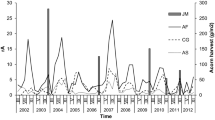Summary
In a 10-year study period, outbreaks of the bank vole, Clethrionomys glareolus, Schreber only occurred in years following huge seed production of European beech, Fagus sylvatica. Intensive winter reprodution preceded the outbreaks, in contrast to a normal breeding season from April through September. No winter reproduction occurred in nearby populations from habitats without mast production. During the winter, the average weight of C. glareolus remained high in the mast forests and the age structure resembled that of a summer breeding population. Despite excess energy requirements of winter breeding, survival rates were similar to that of non-breeding winter populations. In mast years, rodent consumption in the beech forest was estimated as 1.0–10.3% of endosperm production available to postdispersal seed predators. Between mast years rodent consumption made up 30–100% of endosperm production available. Mast years occurred at irregular intervals and seed production seems to be synchronized between individual trees over large areas and induced by climatic events. These phenomena lead to seed predator satiation.
Similar content being viewed by others
References
Adamczewska-Andrzejewska K (1971) Age reference model for Apodemus flavicollis (Melchior). Ekol Polska A 15:787–780
Ashby KR (1967) Studies on the ecology of field mice and voles (Apodemus sylvaticus, Clethrionomys glareolus and Microtus agrestis) in Houghall Wood, Durham. J Zool 152:389–512
Beatley JC (1969) Dependence of desert rodents on winter annuals and precipitation. Ecology 50:721–724
Bergstedt B (1966) Distribution, reproduction, growth and dynamics of the rodent species Clethironomys glareolus (Schreber), Apodemus flavicollis (Melch.) and Apodemus sylvaticus (L.) in Southern Sweden. Oikos 16:132–160
Bobek, B (1971) Influence of population density upon rodent production in a deciduous forest. Ann Zool Fenn 8:137–144
Bujalska G (1973) The role of spacing behaviour among females in the regulation of reproduction in the bank vole. J Reproduction Fert Suppl 19:465–474
Droźdź A (1966) Food habits and food supply of rodents in the beech forest. Acta Theriol 11:363–384
Droźdź A (1968) Digestibility and assimilation of natural foods in small rodents. Acta Theriol 13:467–489
Flowerdew JR (1974) Field and laboratory experiments on the social behaviour and population dynamics of the wood mouse (Apodemus sylvaticus). J Anim Ecol 43:499–511
French NR, Stoddart DM & Bobek B (1975) Patterns of demography in small mammal populations. In: Golley FB et al.: Small mammals, their productivity and population dynamics
Gorecki A (1968) Metabolic rate and energy budget in the bank vole. Acta Theriol 13:341–365
Grodzinski W, Pucek Z & Ryszkowski L (1966) Estimation of rodent numbers by means of prebaiting and intensive removal. Acta Theriol 11:297–314
Hansson L (1971) Small rodent food, feeding and population dynamics. Oikos 22:183–198
Hansson L (1979) Food as a limiting factor for small rodent numbers. Oecologia 37:297–314
Harper JL (1977) Population biology of plants. London
Hörnfeldt B (1978) Synchronous population fluctuations in voles, small game, owls and tularemia in Northern Sweden. Oecologia 32:141–152
Hoffmeyer I & Hansson L (1974) Variability in number and distribution of Apodemus flavicollis (Melch.) and A. sylvaticus (L.) in South Sweden. Z Säugetierk 39:15–23
Holisova V (1971) The food of Clethrionomys glareolus at different population densities. Acta Sci Nat Brno 5 (11):1–43
Holmsgaard E & Olsen HC (1966) Experimental induction of flowering in beech. Det Forstlige Forsøgsvæsen i Danmark 30(1):1–18
Hughes M (1975) Ground, vegetation net production in a Danish beech wood Oecologia 20:251–258
Janzen DH (1971) Seed predation by animals. Ann Rev Ecol Syst 2:465–492
Jensen TS (1975a) Trappability of various functional groups of the forest rodents Clethrionomys glareolus and Apodemus flavicollis, and its application in density estimations. Oikos 26:196–204
Jensen TS (1975b) Population estimation and population dynamics of two Danish forest rodent species. Vid Medd 138:65–86
Jensen TS (1981) Energy flow through Danish forest rodent populations. Nat Jult 19
Kaczmarski F (1966) Bioenergetics of pregnancy and lactation in the bank vole. Acta Theriol 11:409–417
Kalela O, Kilpeläinen L, Koponen T & Tast J (1971) Seasonal differences in habitats of the Norwegian lemming, Lemmus lemmus (L.) in 1959 and 1960 at Kilpisjärvi, Finnish Lapland. Ann Acad Sci Fenn, Ser A, IV Biology 178:1–22
Krebs CJ (1964) The lemming cycle at Baker Lake, Northwest Territories, during 1959–1962. Arctic Institute of North America, Tech Pap No 15
Kulicke H (1960) Wintervermehrung von rötelmaus (Clethrionomys glareolus), erdmaus (Microtus agrestis) und gelbhalsmaus (Apodemus flavicollis). Z Säugetierkunde 25:89–91
Ligon JD (1978) Reproductive interdependence of piñon jays and piñon pines. Ecol Mon 48:111–126
Negus NC & Berger PJ (1977) Experimental triggering of reproduction in a natural population of Microtus montanus. Science 196:1230–1231
Newson R (1963) Differences in numbers, reproduction and survival between two neighbouring populations of bank voles (Clethrionomys glareolus). Ecology 44(1):110–120
Nielsen BO (1977) Beech seeds as an ecosystem component. Oikos 29:268–274
Petrusewicz K, Bujalska G, Andrzejewski R & Gliwicz J (1971) Productivity processes in an island population of Clethrionomys glareolus. Ann Zool Fenn 8:127–132
Reynolds H & Turkowski T (1972) Reproductive variations in the round-tailed ground squirrels as related to winter rainfall. J Mammal 53(4):893–898
Smyth M (1966) Winter breeding in woodland mice, Apodemus sylvaticus, and voles. Clethrionomys glareolus and Microtus agrestis, near Oxford. Journ Anim Ecol 35:471–485
Svärdson G (1957) The “invasion” type of bird migration. British Birds 50:314–343
Tast J, Kaikusalo A (1976) Winter breeding of the root vole Microtus oeconomus in 1972/73 at Kilpisjärvi, Finnish Lapland. Ann Zool Fenn 13:174–178
Wiger R (1979) Demography of a cyclic population of the bank vole Clethrionomys glareolus. Oikos 33:373–385
Zejda J (1962) Winter breeding in the bank vole, Clethrionomys glareolus. Zool Listy 10:249–264
Zejda J (1976) A device serving to determine the birth date of Clethrionomys glareolus by the length of M1 roots. Folia zoologica 26(3):207–211
Author information
Authors and Affiliations
Rights and permissions
About this article
Cite this article
Jensen, T.S. Seed production and outbreaks of non-cyclic rodent populations in deciduous forests. Oecologia 54, 184–192 (1982). https://doi.org/10.1007/BF00378391
Received:
Issue Date:
DOI: https://doi.org/10.1007/BF00378391




